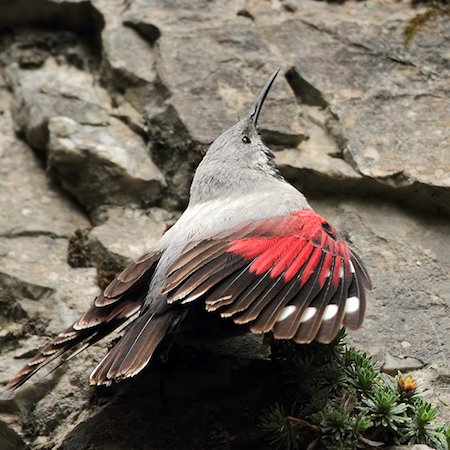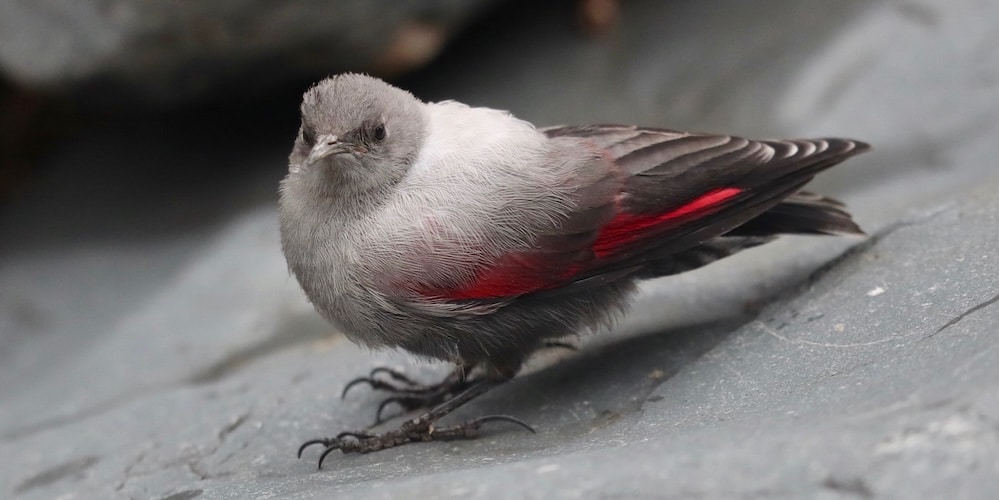Tichodromidae – Wallcreeper

The Tichodromidae family of passerines consists of just one species; the Wallcreeper Tichodroma muraria, which is found throughout the high mountains of Eurasia. It is the only member of the genus Tichodroma.
The Wallcreeper is 15.5–17 centimetres in length, with a mass of 17–19 grams. Its plumage is primarily slate-grey, with darker flight and tail feathers. Its most striking plumage feature, though, are its extraordinary crimson wings. Largely hidden when the wings are folded, this bright colouring covers most of the covert feathers, and the basal half of the primaries and secondaries.
A bird of the high mountains, the Wallcreeper breeds at elevations ranging between 1,000–3,000 metres. It is largely resident across its range, but is known to move to lower elevations in winter, when it is occasionally found on buildings and in quarries. Birds have wintered as far afield as England and the Netherlands. The species is resident across much of the Himalayas, ranging across northern India, Nepal, Bhutan and parts of Tibet as well as the Pyrenees, Alps, Caucasus and other high areas from Spain to Mongolia and China.
It can be quite tame, but is often surprisingly difficult to see on mountain faces. While it may be confiding; vagrant birds especially are tame, they will still hide when they are aware of being watched, and will hesitate before entering the nest and even take roundabout routes towards the nest during prolonged observations.

Wallcreeper Tichodroma muraria – ©Nick Ludovioc Green Bird-Photo-Tours ASIA
Wallcreepers are territorial, and pairs vigorously defend their breeding territory during the summer. During the winter the wallcreeper is solitary, with males and females defending individual feeding territories. Some favour rocky river valleys. The size of these feeding territories is hard to estimate but may comprise a single large quarry or rock massif; or, alternatively, a series of smaller quarries and rock faces. Wallcreepers may travel some distances from roosting sites to feeding territories. They have also been demonstrated showing site fidelity to winter feeding territories in consecutive years.
It is an insectivore, feeding on terrestrial invertebrates, primarily insects and spiders gleaned from rock faces. It sometimes also chases flying insects in short sallies from a rock wall perch. Feeding birds move across a cliff face in short flights and quick hops, often with their wings partially spread.
The female wallcreeper builds a cup nest of grass and moss, sheltered deep in a rock crevice, hole or cave. The nest is lined with softer materials, often including feathers or wool, and typically has two entrances. The female usually lays 4–5 eggs, though clutches as small as three have been found. The white eggs measure 21 mm long, and are marked with a small number of black or reddish-brown speckles. Once her entire clutch has been laid, the female incubates the eggs for 19–20 days, until they hatch. During incubation, she is regularly fed by her mate. Young are altricial, which means they are blind, featherless and helpless at birth. Both parents feed the nestlings for a period of 28–30 days, until the young birds fledge. Each pair raises a single brood a year.
Though largely silent, both male and female wallcreepers sing, the females generally only while defending feeding territories in the winter. The song is a high-pitched, drawn-out whistle, with notes that alternately rise and fall. During the breeding season, the male sings while perched or climbing.
-
Number of bird species: 1
(As at December 2025)
According to the recently (2025) amalgamated AviList, there is just one species, in one genus in the family. It is:
Wallcreeper Tichodroma muraria
-
Tichodromidae
Family AccountAn enigmatic bird of the rocky alpine regions of Europe and Asia, the Wallcreeper blends into gray rock faces... -
Tichodromidae
Family AccountTichodroma is the only known genus in the family Tichodromidae.
Given that this is a family with just one species Fatbirder provides active links below.
-
Wallcreeper Tichodroma muraria
Species AccounteBird https://ebird.org › species › wallcr1 Spectacular in flight, with broad black, red, and white-spotted wings resembling a giant butterfly. -
Wallcreeper Tichodroma muraria
Species AccountSound archive and distribution map. -
Wallcreeper Tichodroma muraria
Species AccountSound archive and distribution map.
